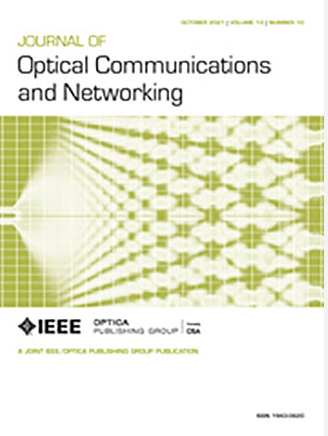MOVE-CU: multi-vendor OpenROADM enhances a virtual environment supporting remote CU-UP migration in a 5G radio network [Invited]
IF 4.3
2区 计算机科学
Q1 COMPUTER SCIENCE, HARDWARE & ARCHITECTURE
引用次数: 0
Abstract
Fifth-generation and beyond (B5G) networks must handle stringent requirements for ultra-low latency, high reliability, and dynamic service provisioning across decentralized environments. While container-based live migration has emerged as a flexible mechanism to ensure service continuity during failures and overload scenarios, most proposed approaches are reactive and lack integration with the transport layer and automation through real-time resource orchestration. This work presents a proactive migration framework that tightly couples a 5G radio access network (RAN) architecture with an OpenROADM-compliant optical transport network (OTN) testbed. By leveraging dynamic optical wavelength service creation and container-based network function virtualization, the presented framework enables seamless live migration of the gNB (next generation) central unit–user plane (CU-UP) between two remote locations without disconnecting the supported mobile services. A custom xApp within the near-real-time RAN intelligent controller (Near-RT RIC) monitors system performance metrics and employs predictive analytics to trigger the proactive CU-UP container migration ahead of a probable server overload scenario. A robot framework-based automation platform ensures coordinated orchestration between the compute and transport layer resource allocation to achieve a successful live migration of the container running the CU-UP. Experimental results confirm that the proposed approach achieves near-zero mobile user service downtime, demonstrating its effectiveness in meeting the end-to-end quality of service (QoS) requirements of B5G applications.MOVE-CU:多厂商OpenROADM增强了一个虚拟环境,支持5G无线网络中的远程CU-UP迁移[邀请]
第五代及以上(B5G)网络必须满足超低延迟、高可靠性和跨分散环境的动态业务供应的严格要求。虽然基于容器的实时迁移已经成为一种灵活的机制,可以确保在故障和过载情况下的服务连续性,但大多数建议的方法都是被动的,缺乏与传输层的集成,也缺乏通过实时资源编排实现的自动化。这项工作提出了一个主动迁移框架,该框架将5G无线接入网(RAN)架构与符合openroadm的光传输网络(OTN)测试平台紧密耦合。通过利用动态光波长业务创建和基于容器的网络功能虚拟化,所提出的框架能够在两个远程位置之间实现gNB(下一代)中央单位用户平面(CU-UP)的无缝实时迁移,而无需断开所支持的移动服务。近实时RAN智能控制器(Near-RT RIC)中的自定义xApp监视系统性能指标,并使用预测分析在可能的服务器过载场景之前触发主动的CU-UP容器迁移。基于机器人框架的自动化平台确保了计算层和传输层资源分配之间的协调编排,以实现运行CU-UP的容器的成功实时迁移。实验结果证实,该方法实现了接近零的移动用户业务停机时间,证明了其在满足B5G应用的端到端服务质量(QoS)要求方面的有效性。
本文章由计算机程序翻译,如有差异,请以英文原文为准。
求助全文
约1分钟内获得全文
求助全文
来源期刊
CiteScore
9.40
自引率
16.00%
发文量
104
审稿时长
4 months
期刊介绍:
The scope of the Journal includes advances in the state-of-the-art of optical networking science, technology, and engineering. Both theoretical contributions (including new techniques, concepts, analyses, and economic studies) and practical contributions (including optical networking experiments, prototypes, and new applications) are encouraged. Subareas of interest include the architecture and design of optical networks, optical network survivability and security, software-defined optical networking, elastic optical networks, data and control plane advances, network management related innovation, and optical access networks. Enabling technologies and their applications are suitable topics only if the results are shown to directly impact optical networking beyond simple point-to-point networks.

 求助内容:
求助内容: 应助结果提醒方式:
应助结果提醒方式:


